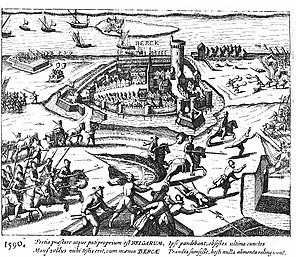| Siege of Rheinberg (1586–1590) | |||||||
|---|---|---|---|---|---|---|---|
| Part of the Eighty Years' War and the Cologne War | |||||||
 The Siege of Rheinberg of 1590 by Peter Ernst von Mansfeld. | |||||||
| |||||||
| Belligerents | |||||||
|
(Gebhard Truchsess) |
| ||||||
| Commanders and leaders | |||||||
|
(From 1590) |
| ||||||
| Cologne War | |
|---|---|
The siege of Rheinberg 1586–1590, also known as the capture of Rheinberg of 1590, took place at the strategic Cologne enclave of Rheinberg (present-day North Rhine-Westphalia, Germany), one of the principal crossing-points over the Rhine on the stretch between the Electorate of Cologne and the Dutch border, between 13 August 1586 and 3 February 1590, during the Eighty Years' War, the Cologne War, and the Anglo-Spanish War (1585–1604). After an initial siege in 1586, and a long blocking by the Spanish forces until September 1589, Don Alexander Farnese, Duke of Parma (Spanish: Alejandro Farnesio), commander-in-chief of the Spanish army, sent a substantial force, under Peter Ernst, Count of Mansfeld, to besiege Rheinberg. Despite the efforts by Maarten Schenck van Nydeggen (until his death at the Assault on Nijmegen on 10 August 1589), and Sir Francis Vere (from 1590), to relieve the fortress city, the Protestant garrison finally surrendered to the Spaniards on 3 February 1590.
On 19 August 1597 the Dutch army led by Maurice of Nassau captured Rheinberg for the States in his successful campaign of 1597, but the following year the Spanish Army of Flanders led by Don Francisco de Mendoza retook the strategic place, forcing the garrison to surrender.
See also
- Cologne War
- Army of Flanders
- Destruction of Neuss
- Assault on Nijmegen (1589)
- List of Archbishop-Electors of Cologne
Notes
- ^ Wilson p.210
- ^ Israel p.29
- He (Duke of Parma) then moved north to capture Rheinberg in February 1590, a Cologne enclave that provided access across the Rhine and facilitated the subsequent campaigns to outflank the Dutch Republic from the east. Wilson p.210
- Hennes pp.177–179
- ^ Brodek pp.400–401
- It was the occupation of Rheinberg by Spanish troops in that month which marked the inauguration of the fixed network of Spanish garrisons in north-west Germany. Israel p.29
- Luc Duerloo p.46
- Israel pp.29–30
- Juan Valera p.521
References
- Hennes, Johann Heinrich. Der Kampf um das Erzstift Köln zur Zeit der Kurfürsten. Köln: DuMont-Schauberg. 1878. (in German)
- Benians, Ernest Alfred, et al. The Cambridge Modern History. New York: MacMillan. 1905.
- Hamish Wilson, Peter. The Thirty Years War: Europe's Tragedy. First published 2009 by Penguin Group. ISBN 978-0-674-03634-5
- Brodek, Theodor V. Socio-Political Realities of the Holy Roman Empire. Journal of Interdisciplinary History. 1971.
- Luc Duerloo. Dynasty and Piety: Archduke Albert (1598–1621) and Habsburg Political Culture in an Age of Religious Wars. MPG Books Group. UK.
- Parker, Geoffrey. The Army of Flanders and the Spanish Road, 1567–1659. Cambridge: Cambridge University Press. 2004. ISBN 978-0521543927
- Juan Valera. Homenaje a Menéndez Pelayo. Estudios de Erudición Española. Madrid, 1899. (in Spanish)
- Jonathan I. Israel. Conflicts of Empires: Spain, the Low Countries and the Struggle for World Supremacy 1585–1713. London. 1997. ISBN 1-85285-161-9
External links
Categories:
- Sieges of the Eighty Years' War
- Sieges involving Spain
- Sieges involving the Dutch Republic
- Sieges involving England
- 1590 in the Holy Roman Empire
- Conflicts in 1586
- Conflicts in 1587
- Conflicts in 1588
- Conflicts in 1589
- Conflicts in 1590
- 1586 in the Holy Roman Empire
- 1587 in the Holy Roman Empire
- 1588 in the Holy Roman Empire
- 1589 in the Holy Roman Empire
- 16th-century military history of the Kingdom of England